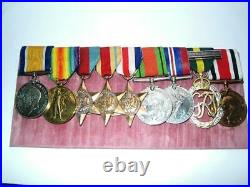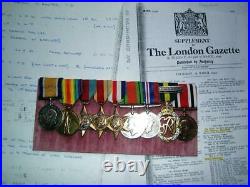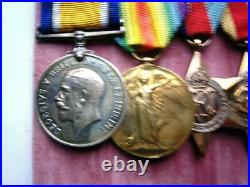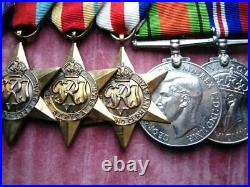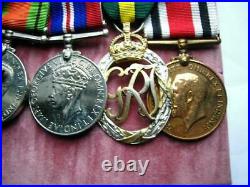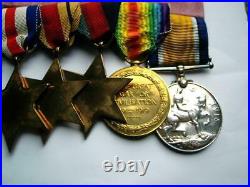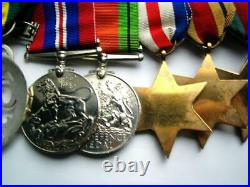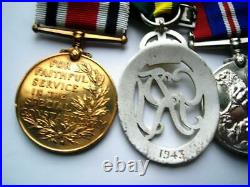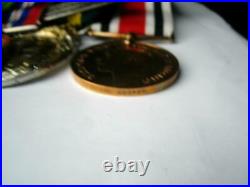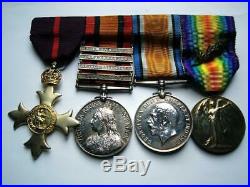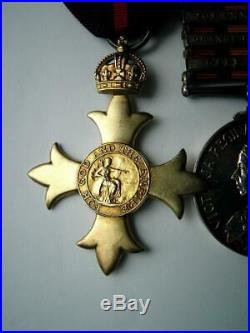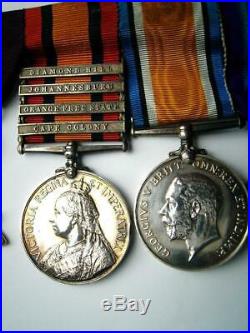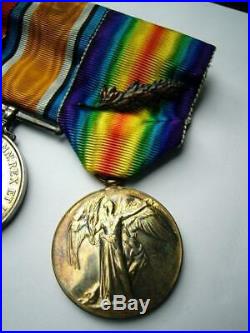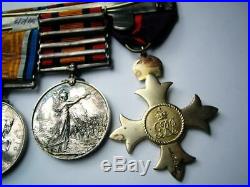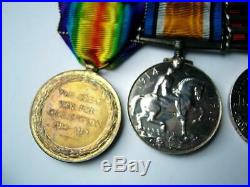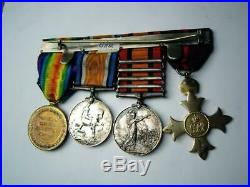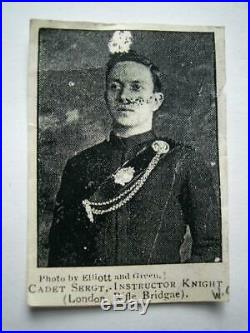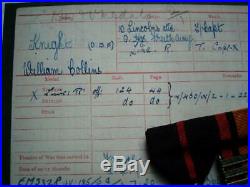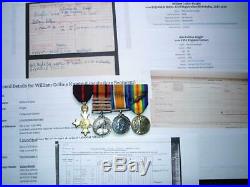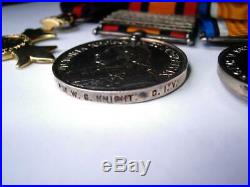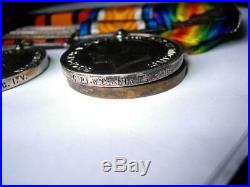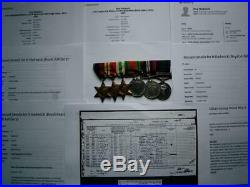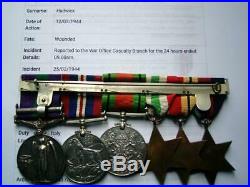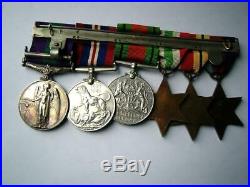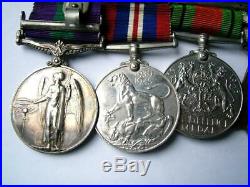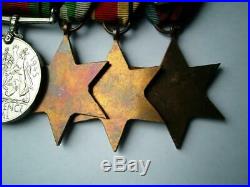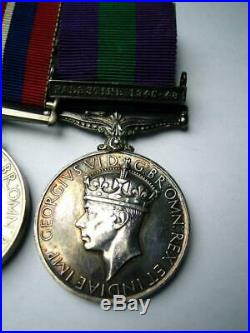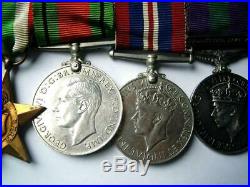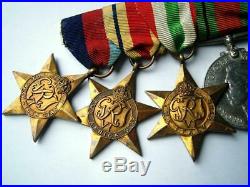IMO Very fine condition plus, OBE, Mentioned in dispatches medal group awarded to Major William Collins Knight. The Most Excellent Order of the British Empire, O. ; British War and Victory Medals, with M. Oak leaves, official impressed, Capt. WW1 served in the 10th Lincolnshire Regt, “Grimsby Chums”, Slight wear, few minor marks, light bruise to QSA, Very fine or better. Promoted Major when awarded OBE. Major Knight WW1 OBE MID Victorian QSA City London Volunteer War & Victory medal. Boer War WW1 OBE MID British War & Victory medals Major Knight City of London Volunteers & Lincolshire Regt IMO Very fine condition plus, OBE, Mentioned in dispatches medal group awarded to Major William C Knight. WW1 served in 10th Btn Lincolnshire Regt, “Grimsby Chums”, Slight wear, few minor marks, light bruise to QSA, Very fine or better. London Gazette 3 June 1919: For valuable service rendered in connection with military operations in France William Collins Knight was born in Wandsworth, London in 1878, Father William Thomas Knight and Mother Georgiana Northmore Knight, he had one older sister and four younger brothers (1891 census). He joined the 1st City of London Rifle Volunteers in 1896 and was a Cadet Sergeant-Instructor in that unit, while civilly employed as a clerk in the drapery trade, when he volunteered for the City of London Imperial Volunteers in 1900. He served in the Infantry Battalion of the C. During the Boer War. An article in the City Press, 14 November 1900, reports on a dinner for 6 returning C. In 1906 he married Lilly Warren in Wandsworth, London. In the 1911 census they were living in Streatham, London, had a daughter aged 2 and servant. Following the outbreak of the Great War, Knight was commissioned Temporary Lieutenant in the 9th (Reserve) Battalion (aged about 35), Lincolnshire Regiment on 10 December 1914 and promoted Temporary Captain, attached 10th Battalion, Lincolnshire Regiment ” Grimsby Chums”, on 1 April 1916, serving on the Western Front from 2 April 1917. Staff, Fourth Army, he was Mentioned in Field Marshal Haigs Despatch of 16 March 1919 (London Gazette 8 July 1919), promoted to Major and for his services during the Great War was appointed an Officer of the Order of the British Empire. He died in 1936 aged 58, recorded Battersea, London. Paperwork of history included, medal index card WW1 for WW1 pair, OBE & MID, medal roll extract for QSA, not entitled KSA. BATTLE OF DIAMOND HILL. This took place on 11 and 12 June 1900 during the Second Boer War. Fourteen thousand British soldiers squared up against four thousand Boers and forced them from their positions on the hill. The British cavalry were under the command of Sir Ian Hamilton. He despatched Robert Broadwood’s 2nd Cavalry brigade, which included the 10th Royal Hussars, 12th Royal Lancers and the Household Cavalry Regiment, on a Special Mission. As the sun came up it was a bitterly cold Monday morning… We are hidden in the hills at Donkerhoek… Confided Botha to his diary. As a detachment of 10th Hussars swung off to the right, they were attacked from Diamond Hill. A section of Q Battery RHA attempted to return artillery fire, but had no infantry support, until the 12th Lancers arrived on the front line. The Boers pressed the matter hard. Two squadrons of Household Cavalry Regiment and one squadron of the 12th Hussars charged at full gallop at Boers firing from concealed positions. On 13th the Botha’s army retreated to the north, they were chased as far as Elands River Station, only 25 miles from Pretoria, by Mounted Infantry and De Lisle’s Australians. Forty-four years after the battle, British General Ian Hamilton opined in his memoirs that “the battle, which ensured that the Boers could not recapture Pretoria, was the turning point of the war”. Hamilton credited Winston Churchill with recognizing that the key to victory would be in storming the summit, and risking his life to signal Hamilton. Lincolnshire Regiment 9th (Reserve) Battalion (December 1914 to April 1916) Formed in Lincoln in November 1914 as Service battalion, part of K4. November 1914 : came under command of 91st Brigade, original 30th Division. February 1915: moved to The Hayes, Swanwick in Derbyshire. 10 April 1915 : became a reserve battalion. Lincolnshire Regiment 10th (Service) Battalion (Grimsby) (April 1916 to April 1917) Often known by its original name of the Grimsby Chums. Formed at Grimsby on 9 September 1914 by the Mayor and Town. June 1915 : came under command of 101st Brigade, 34th Division. FOURTH ARMY HQ movements (April 1917 – 1919) 15 April 1917: Villers Carbonnel 5 July 1917: Malo-les-Bains 25 October 1917 : Rosendael (Dunkirk) 5 November 1917 : Dury 9 November 1917: staff and HQ of Fourth Army takes over from Second Army at Cassel. On 20 December 1917 what had been Second Army was renamed as Fourth Army. On 13 March 1918 the units under Fourth Army were placed under command of the reconstituted Second Army and four days later what had been Fourth Army was renamed as Second Army. 22 March 1918 : Querrieu 25 March 1918 : Picquigny-sur-Somme 27 March 1918 : Abbeville. Next day, Fourth Army took over command of Fifth Army. The latter ceased to exist on 2 April 1918. 30 March 1918 : Auxi-le-Chateau 31 March 1918 : Flixecourt 2 April 1918 : Dury 5 April 1918 : Flixecourt. 30 August 1918 : Bertangles 25 September 1918 : Eterpigny 14 October 1918 : Montigny Farm (Roisel, HQ located in a train) 3 November 1918 : Honnechy (in a train) 16 November 1918 : Avesnes 30 November 1918 : Ham-sur-Heure 10 December 1918 : Namur. FOURTH ARMY BATTLES WW1 from April 1917 Pursuit of the German retreat to the Hindenburg Line (March-April 1917) The Battle of Amiens (August 1918) The Second Battles of the Somme 1918 (August-September 1918) The Battles of the Hindenburg Line (September-October 1918) The final advance in Picardy (October-November 1918). Create your brand with Auctiva’s. Attention Sellers – Get Templates Image Hosting, Scheduling at Auctiva. Track Page Views With. Auctiva’s FREE Counter. The item “Major Knight WW1 OBE MID Victorian QSA City London Volunteer War & Victory medal” is in sale since Tuesday, August 25, 2020. This item is in the category “Collectables\Militaria\19th Century (1800-1899)\Medals/ Ribbons”. The seller is “theonlineauctionsale” and is located in Offchurch. This item can be shipped worldwide.
- Country/Region of Manufacture: United Kingdom
- Country/ Organization: Great Britain
- Issued/ Not-Issued: Issued
- Type: Medals & Ribbons
- Conflict: Boer War (1899-1902)
- Service: Army
- Era: 1816-1913
